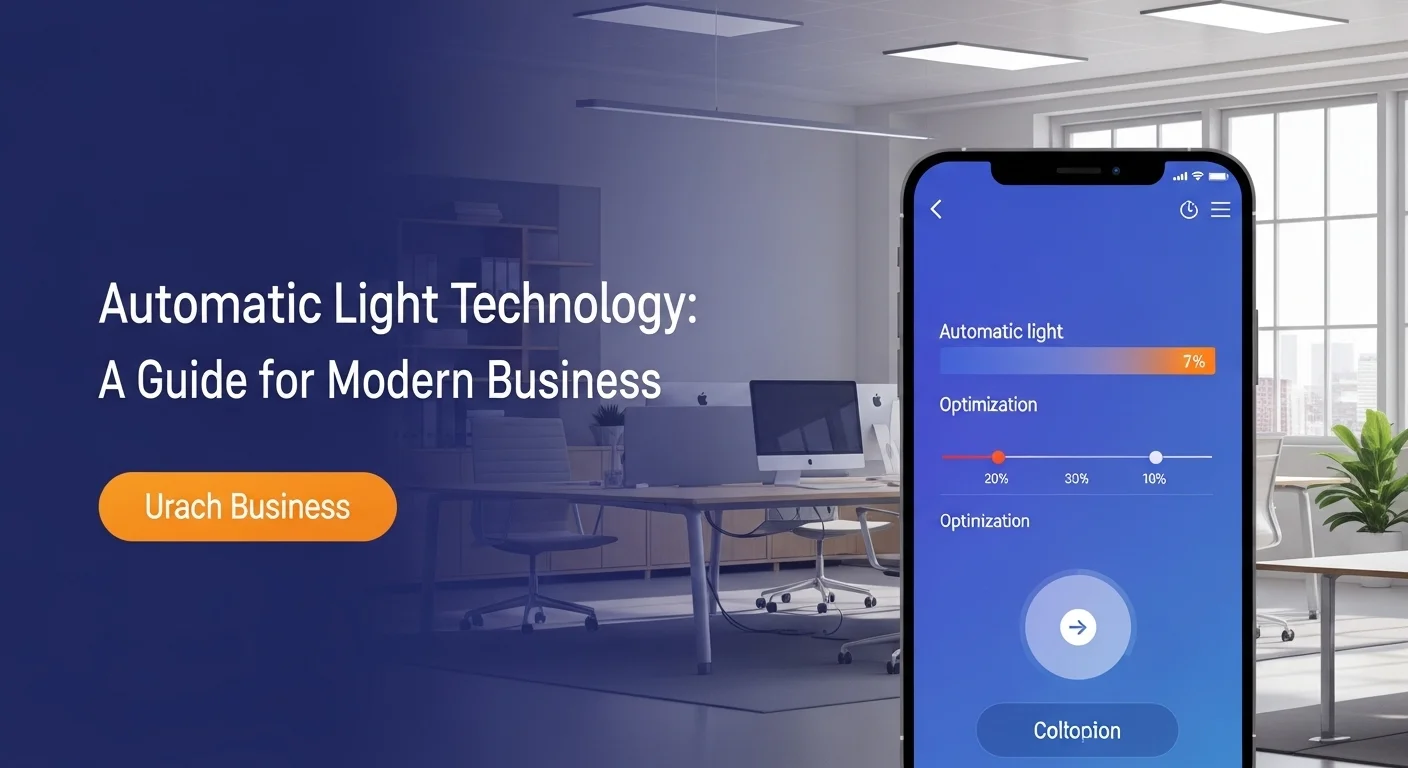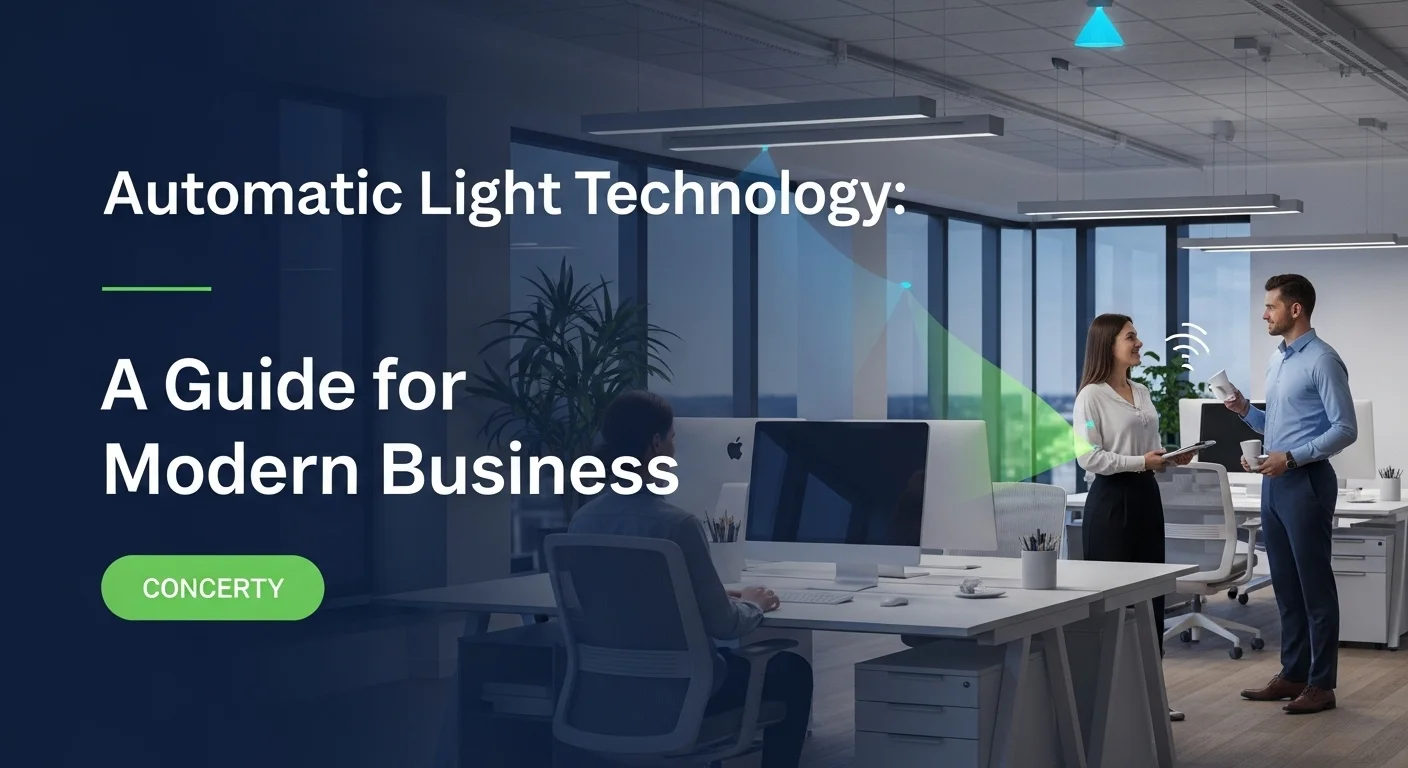Your Ultimate Guide to Automatic Light: Transforming Business with Smart Lighting

Executive Summary
I've spent over a decade helping businesses integrate smart technology, and if there's one game-changer that consistently delivers, it's automatic lighting. It's so much more than a fancy motion sensor. We're talking about a sophisticated system that thinks for itself, using sensors, AI, and IoT to create the perfect environment. For businesses, this means serious energy savings, happier and more productive teams, and even tighter security. For tech lovers, it's a beautiful dance of hardware and software that's literally lighting up our future. This guide is my way of sharing what I've learned on the ground—cutting through the jargon to show you how a smart lighting system can be one of the best strategic moves you make for your business's efficiency and sustainability.
Table of Contents
What is Automatic Light and Why is it so Important?
Table of Contents
In the world of tech, we love to automate everything. But I've noticed that one of the most powerful automations is often the one right above our heads: lighting. Automatic light isn't just a convenience; it's a cornerstone of modern smart design, blending energy efficiency with a genuinely better user experience. For any business I've worked with, understanding this technology has been a key step toward a smarter, more efficient operation. At its heart, an automatic light system is simply a setup that controls lighting without you having to flick a switch. It uses different kinds of 'senses' to make smart decisions about when and where light is needed, and how bright it should be. This is a huge leap from traditional, manual systems. The reason this matters so much today is its massive impact on energy consumption. Lighting is a huge chunk of any building's electricity bill, and I've seen firsthand how automating it can lead to incredible savings and a much smaller carbon footprint.
The Core Concept: From Simple Sensors to Smart Networks
Automatic lighting started out with those simple motion detectors you'd see in a hallway. Today, that technology has grown into a complete ecosystem. A modern automatic light control system is a smart network of devices all talking to each other to create the perfect lighting atmosphere. Think of it like a team: you have the sensors, the controller, and the lights themselves.
Sensors are the eyes and ears of this team. The most common ones I encounter are:
- Passive Infrared (PIR) Sensors: These are the classics. They detect body heat and are perfect for enclosed rooms. They just need a clear line of sight to do their job.
- Ultrasonic Sensors: These guys send out sound waves that are too high for us to hear. They detect movement when something interrupts those waves. The cool part? They can 'see' around corners and obstacles, making them great for restrooms with stalls.
- Microwave Sensors: Working like ultrasonic sensors but with microwaves, these are extremely sensitive and can even pick up motion through thin walls. They need careful setup to avoid being overeager.
- Photocells (Light Sensors): I love these. They measure the amount of natural daylight in a room, which is the key to a strategy called 'daylight harvesting' that we'll touch on later.
Why It Matters for Modern Businesses
Integrating an automatic electric lighting control system is more than a tech upgrade; it's a smart business decision. The benefits I've seen clients experience go far beyond just automating the lights.
1. Unprecedented Energy Efficiency: This is the headline benefit, and for good reason. An automated system makes sure lights are only on when and where they're needed. I've seen strategies like occupancy sensing and daylight harvesting slash lighting energy costs by 25-30% consistently. By dimming lights when a room is empty or when the sun is pouring in, businesses can make a serious dent in their utility bills. It's a win for the budget and a win for the planet.
2. Enhanced Comfort and Productivity: I always tell my clients that happy employees are productive employees. Good lighting is essential for well-being. Automatic systems maintain perfect, consistent light levels, getting rid of annoying glare or dim corners. Some advanced systems I've installed even support 'human-centric lighting,' which adjusts the light's color and temperature throughout the day to match our natural body clocks. This can genuinely improve mood, focus, and even sleep quality.
3. Improved Safety and Security: This is a benefit that often gets overlooked. Think about motion-activated lights in parking garages, stairwells, and hallways. They ensure safe passage and reduce the risk of accidents. From a security standpoint, a building that looks alive is a poor target for intruders. An automatic electric lighting control system can be programmed to mimic normal occupancy, creating a 'lived-in' look even when the building is empty—a simple but effective security boost.
4. Reduced Maintenance and a Longer Lifespan: It's simple logic: if your lights are on less, they last longer. This means fewer bulb replacements and lower maintenance costs over time. The centralized systems I work with can also track usage and flag potential failures before they happen. This allows for scheduled, proactive maintenance instead of disruptive, reactive repairs.
5. The Gateway to a Truly Smart Building: For me, this is the most exciting part. An automatic room light control system is rarely an island anymore. It's a key player in a fully integrated smart building. The occupancy data from your lighting sensors can tell your HVAC system to stop heating an empty room, creating even more savings. This connection between systems, often managed by a Building Management System (BMS), is what turns a regular building into a responsive, intelligent environment. Your automatic room light controller becomes a data point in a bigger network, making the whole building smarter. In my experience, adopting a comprehensive automatic light control system is no longer a luxury—it's a strategic necessity for any forward-thinking organization.

The Complete Playbook for Automatic Light in Your Business
So, you're sold on the 'why.' Now let's get into the 'how.' Moving from theory to a real-world, effective automatic light control system involves understanding the tech, making smart business moves, and knowing where to look for reliable information. This isn't about buying a one-size-fits-all box. From my experience, the best results come from tailoring a solution that fits your specific space and goals perfectly.
The Tech That Makes It All Work
The magic of any automatic electric lighting control system comes from its core technology. Getting a handle on these components is key to designing a system that works flawlessly without frustrating your team.
Choosing the Right Sensor for the Job:
I've seen projects stumble because the wrong sensor was used in the wrong place. Here’s my quick cheat sheet:
- Passive Infrared (PIR): Your go-to for enclosed spaces like private offices or supply closets. They're cost-effective, but can miss someone sitting still for a long time.
- Ultrasonic: Perfect for rooms with obstacles, like bathrooms with stalls or libraries with bookshelves. The sound waves are great at navigating around things. Just be aware they can sometimes be triggered by vibrations from vents or machinery.
- Dual-Technology (PIR + Ultrasonic): This is the gold standard for reliability. I recommend these for classrooms, conference rooms, and open offices. Typically, either sensor can turn the lights on, but both have to agree that the room is empty before turning them off. It’s the best way to avoid false-offs.
- Microwave: These are the most sensitive and can even see through some walls. They have their place, but require expert calibration to prevent them from turning the lights on every time someone walks down the hall.
- Digital Light Sensors (Photocells): These are the heroes of energy efficiency. They constantly measure how much natural light is in the room and tell the automatic room light controller to dim the artificial lights to the perfect level.
Once a sensor detects something, it needs to send that message. This happens over a network, which can be wired or wireless.
- Wired: Think of this as the reliable landline. A protocol called DALI is a fantastic two-way street, allowing you to control and get feedback from every single light fixture. It’s powerful and secure. The simpler 0-10V is another common wired standard for basic dimming.
- Wireless: This is the flexible cell phone. Protocols like Zigbee and Bluetooth Mesh are amazing for existing buildings where running new wires is a nightmare. They drastically cut down on installation costs, but you have to think about things like signal range and cybersecurity.
This is where things get really cool. The newest systems I'm installing use AI to learn your building's usage patterns. They can move from just reacting to a person walking in, to predicting that a meeting room needs to be lit and ready at 8:55 AM for a 9:00 AM meeting. The cloud allows facility managers to monitor and control the entire automatic light control system from a laptop or phone, anywhere in the world. It’s a game-changer for managing multiple locations.
The Business Strategy Behind the Tech
For a business, investing in an automatic electric lighting control system is a financial decision. Here’s how to approach it.
1. Start with a Lighting Audit: Before you can improve, you have to measure. I always start by walking the site, inventorying every light, and understanding how the space is actually used. This data becomes your baseline to calculate potential savings and build a compelling case for the investment.
2. Nail the Return on Investment (ROI): A clear ROI is your best friend when getting project approval. Add up the upfront costs (hardware, installation) and weigh them against the projected annual savings from energy, maintenance, and even utility rebates. I've seen many advanced systems pay for themselves in just a couple of years.
3. Think Integration, Not Isolation: To get the biggest bang for your buck, your lighting system shouldn't be an island. Integrating it with your Building Management System (BMS) is key. When your lighting sensors can tell your HVAC to power down in an empty wing of the building, you start to see compounded savings.
4. Don't Forget Cybersecurity: I have to stress this: anything connected to your network is a potential security risk. I've heard horror stories of hackers using an unsecured lighting network as a backdoor into a company's main servers. Prioritize systems with strong encryption and work with your IT team to properly segment the network. It's not optional.
5. Pick the Right Partner: The market is flooded with options. Look for a vendor who can provide a complete solution, from design to long-term support. Compare different platforms—some are simple and app-based for small businesses, while others are powerful enterprise solutions for large campuses. The right automatic room light controller and system depend entirely on your scale and needs.
Resources to Guide You
You're not alone in this. Groups like the DesignLights Consortium (DLC) maintain lists of high-quality, rebate-eligible products. Industry case studies are also a goldmine of real-world lessons. When comparing systems, I always advise clients to ask: Is it scalable? Does it play well with other systems (using open standards)? Is it easy for my team to use? And what's the total cost of ownership, not just the sticker price? By taking this strategic approach, you can implement a lighting system that delivers incredible value for years to come.

My Pro Tips for Mastering Your Automatic Lighting System
Getting an automatic light system installed is just the first step. The real magic happens when you fine-tune it to create an experience that's so seamless, people don't even notice it's there—they just know the lighting is always perfect. As someone who has deployed and optimized these systems for years, here are my go-to tips and strategies to get the absolute most out of your automatic light control system.
Best Practices for a Flawless Launch
A great user experience starts with a smart installation and setup. Getting these early steps right is crucial.
1. Design for Humans, Not Just for Efficiency: I've seen it happen: a system is so aggressive with its energy saving that it turns the lights off on someone who's just sitting still reading. This is the #1 complaint. Avoid it by designing with intuitive manual overrides. Put a simple switch in the places people expect it. A great system should feel helpful, not bossy. Also, program lights to dim down gradually instead of snapping off abruptly; it's a small touch that makes a huge difference.
2. Sensor Placement is Everything: The performance of your automatic room light control system lives and dies by its sensors. During installation, make sure they have a clear view of the area they're covering. A common mistake I see is placing a PIR sensor right in the path of an HVAC vent, which can cause false triggers from blasts of hot or cold air. After installation comes 'commissioning'—the fine-tuning process. Set your time delays carefully. Too short, and you'll annoy people. Too long, and you'll waste energy. It's a balance.
3. Create Smart Control Zones: Don't treat an entire floor as one big zone. Group lights logically based on how the space is used. For example, in an open office, the lights by the windows should be on a different control schedule than the lights in the interior core. A good automatic electric lighting control system will let you create these granular zones, making your control infinitely more effective.
4. Don't Skip the Training: Your facilities team needs to know this system inside and out. Train them on how to adjust settings, understand alerts, and perform basic troubleshooting. I also recommend a quick 'welcome' guide for building occupants, explaining how the system works and how to use the overrides. A little bit of education goes a long way toward user happiness.
My Favorite Advanced Strategies for Optimization
Once you're up and running, you can start layering in more advanced techniques to unlock even more savings and a better experience.
1. Daylight Harvesting: The Easiest Big Win: This is my favorite strategy. It uses photocells to measure incoming sunlight and automatically dims the indoor lights to maintain the perfect light level. On a bright, sunny day, you might be using only 10% of your lighting energy near the windows. It’s an elegant, effective way to save money.
2. Task Tuning (or 'High-End Trim'): The Hidden Saver: Most lights are installed to be brighter than necessary. Task tuning is the simple act of setting a maximum brightness level for a space based on what it's used for. A hallway doesn't need to be as bright as a design studio. Through the system's software, you can 'trim' the max output to 70%, for example. No one will notice the difference in brightness, but you'll see a 30% savings in that zone, instantly.
3. Smart Scheduling: The Set-it-and-Forget-it-Strategy: Program your system around your business hours. Schedule a 'sweep' to turn all lights off at 8 PM, for instance. This prevents the entire building from staying lit all night for just one or two late workers. Modern systems can even use an 'astronomic' clock that knows the exact sunrise and sunset times in your location to control exterior lighting perfectly year-round.
4. Demand Response: Get Paid to Save Energy: This is for next-level operators. Many utility companies offer programs where they'll pay you to reduce your energy use during peak demand hours. An advanced automatic electric lighting control system can be programmed to receive a signal from the utility and automatically dim all lights by 10-15% for a couple of hours. It’s a subtle change that can generate a whole new revenue stream for your business.
Stay Ahead of the Curve
- Use Your Data: The analytics dashboard in your lighting software is a goldmine. I use it to spot trends. Is one area always empty? Maybe you can repurpose that space. Are the lights in the conference room constantly being overridden? The settings probably need a tweak. AI-powered systems can even crunch this data for you and give you actionable insights.
- Ask for Feedback: Create a simple way for people to tell you what they think of the lighting. This feedback is priceless for making continuous improvements and ensuring your automatic room light controller is serving its ultimate purpose: the people in the building.
Expert Reviews & Testimonials
Sarah Johnson, Cafe Owner ⭐⭐⭐⭐
As a small business owner, I found this really insightful. The breakdown of ROI was helpful, but I'd love to see a future article on affordable, entry-level systems for businesses like mine.
Mike Chen, IT Consultant ⭐⭐⭐⭐⭐
As an IT consultant, I particularly appreciated the section on cybersecurity and network integration. It's a crucial point that's often overlooked in articles about IoT devices. Well-written, practical, and clear.
Emma Davis, Systems Engineer ⭐⭐⭐⭐⭐
Finally, an article that puts it all together! I've read a lot about smart lighting, but this is the first guide that clearly connects the tech specs to real-world business strategy. The section on advanced strategies like demand response was brilliant. A must-read.



